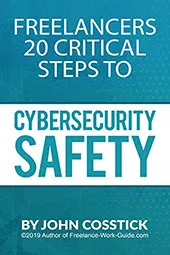Data Security Tips- Data security is essential for all businesses. Cyber threats are rapidly increasing, placing important information at risk. It’s crucial to protect customer data, financial records, and ideas. Without good cybersecurity, businesses face big risks. These include data breaches, financial loss, and lost trust.
In today’s digital world, businesses must act fast. Cybercriminals use new ways to find weaknesses. Companies need solid steps to stay safe.

This article offers real tips to lower risks and create a safer online space. You’ll learn how to stop breaches, keep operations safe, and keep customers trusting you.
Key Takeaways
- Data security tips help defend against evolving cyber threats.
- Cybersecurity tips protect business reputation and finances.
- Proactive measures reduce the risk of data breaches.
- Employee awareness is critical for effective security.
- Strong cybersecurity practices improve customer trust.
Understanding the Importance of Data Security in Today’s Business Environment
Data security is more than just a technical need; it’s a key to business survival. With cyber threats growing every day, all businesses face big risks. It’s crucial to have strong data protection strategies and ways to prevent data breaches.
The Rising Threat Landscape for Businesses
Ransomware, phishing, and insider threats are major concerns. The FBI saw a 70% jump in cybercrime complaints in 2023. Small businesses were hit the hardest, making up 43% of cases. Key trends include:
- Phishing emails targeting employees
- Ransomware attacks demanding millions in crypto payments
- Third-party vendor vulnerabilities
Financial Impact of Data Breaches
Financial losses go beyond the immediate costs. The average breach costs $4.45 million in 2023, IBM reports. Costs vary by business size:
|
Business Size |
Average Breach Cost |
|
Small (1-500 employees) |
$2.5 million |
|
Medium (500-2,500 employees) |
$4.8 million |
|
Larger (2,500+ employees) |
$6.2 million |
Reputational Consequences of Security Incidents
“A single breach can erode customer trust faster than years of marketing can rebuild it.”
Target’s 2013 breach lost them 40% of their profits. It shows how fast trust can disappear. After a breach, 60% of small businesses close within six months. Partners, investors, and customers all question their relationships after such incidents.
Essential Data Security Tips for Business Protection
Data security tips are key to fighting cyber threats. Businesses need a multi-layered approach to protect sensitive info. Each layer helps lower risks and keeps operations running smoothly.
- Encrypt all sensitive data at rest and in transit
- Limit access to critical systems using role-based permissions
- Conduct regular security audits to identify vulnerabilities
- Update software and systems immediately when patches are released
|
Defense Layer |
Implementation Example |
|
Network Security |
Firewalls and intrusion detection systems |
|
Physical Security |
Secure server rooms with biometric access |
|
Employee Training |
Quarterly phishing simulation exercises |
|
Data Backup |
Offsite encrypted backups done weekly |
“Defense in depth ensures that no single failure can compromise your entire system.”
Effective data security measures balance protection and accessibility. Too strict rules can slow down work, while too loose can raise risks. Conducting security tests during low-traffic periods helps prevent major issues.
Regular training for employees and automated checks make a strong yet working security system.
Implementing Strong Authentication Protocols
Strong authentication protocols are key to keeping business data safe. Online security best practices involve using several verification steps. This ensures only authorized users can access sensitive information.
Multi-Factor Authentication Best Practices
Multi-factor authentication (MFA) adds extra layers of protection. It combines different verification methods like passwords, codes, and physical tokens. Here are some important steps:
- Require MFA for all employee accounts that handle sensitive data.
- Choose platforms that support FIDO2 or U2F standards for device-based authentication.
- Test MFA workflows to avoid disrupting user productivity.
Password Management Strategies
Weak passwords are a major vulnerability. Follow these online security best practices:
- Enforce 12+ character passwords with a mix of symbols, numbers, and uppercase letters.
- Implement password managers like 1Password or Bitwarden for team use.
- Disable default credentials and mandate regular password rotations every 90 days.
Biometric Security Considerations
Biometric systems offer convenience but need careful evaluation. Here’s a comparison of common methods:
|
Method |
Advantages |
Limitations |
|
Fingerprint Scans |
Quick access, low cost |
Can be replicated with lifted prints |
|
Facial Recognition |
Non-invasive, widely adopted |
Poor lighting or masks reduce accuracy |
|
Behavioral Biometrics |
Continuous authentication tracking user patterns |
Requires extensive data collection for accuracy |
Securing Your Network Infrastructure
A strong network infrastructure is key to protecting your business. These tips help secure your data by setting up your network wisely. Focus on firewalls, Wi-Fi, and how remote access works.
Firewall Configuration and Management
Choose the right firewall for your business. You have a few options:
- Hardware firewalls: Physical devices for the first line of defense
- Software firewalls: Installed on servers or computers
- Next-gen firewalls: They catch intrusions and block threats
Keep your firewall rules up to date. Also, limit access to important systems.
Secure Wi-Fi Deployment
Set up Wi-Fi with WPA3 encryption and network sections. Keep guest networks separate from yours. Watch for any unknown devices:
- Switch to WPA3 for better security
- Divide networks to reduce data risk
- Use guest portals for visitors
VPN Implementation for Remote Access
To protect remote teams, implement VPNs with the following best practices:
- Pick top-notch VPNs like Cisco or Palo Alto
- Use AES-256 encryption and multi-factor authentication
- Check connections every month for security issues
Regular checks make sure your setup follows best practices.
Data Encryption Strategies for Sensitive Information
Data encryption is key to safeguarding sensitive information in any business. It makes data unreadable without the right keys. This acts as a strong defense against unauthorized access. It’s crucial for both data stored and data sent online.
- Data at rest: Use AES-256 encryption for stored files like customer databases or financial records.
- Data in transit: Deploy SSL/TLS protocols to protect emails, cloud backups, and remote access traffic.
Encryption keys must be kept safe. Don’t store keys with encrypted data. Use hardware security modules (HSMs) or cloud-based key management services. Privacy protection tips also include regular checks of encryption and training employees on safety.
“Encryption isn’t optional—it’s a necessity for businesses handling personal or financial data.” – National Institute of Standards and Technology (NIST)
For businesses, using end-to-end encryption in communications and cloud storage is a must. It helps meet GDPR rules. Focus on encrypting high-risk data like customer info, intellectual property, and payment details. Encryption is vital for data in servers, mobile devices, or clouds. It turns complex tech into a trust and compliance asset.
Employee Training and Security Awareness
Employees are the first line of defense in any data protection strategy. Regular training programs help reduce risks. They strengthen data protection strategies that prevent costly breaches.
Recognizing Phishing and Social Engineering Attempts
Phishing attacks often mimic trusted sources. Teach staff to spot red flags like:
- Urgent requests for personal information
- Unofficial email domains
- Unsolicited attachments
Real-world examples include fake Microsoft login pages or vishing calls claiming IT support. Report suspicious activity immediately.
Safe Data Handling Protocols
|
Data Type |
Handling Protocol |
|
Customer records |
Encrypted storage, restricted access |
|
Financial data |
Double-approval processes, audit trails |
|
Internal memos |
Password-protected sharing, automatic deletion after 30 days |
Follow these preventing data breaches steps to align with industry standards like GDPR compliance.
Building a Security-First Culture
- Quarterly simulated phishing tests
- Reward teams with 0 breach incidents yearly
- Quarterly security newsletters with case studies
Track progress through quiz scores and incident reports. A culture of vigilance turns security into a shared responsibility.

Developing an Effective Data Breach Response Plan
Even with strong digital security, breaches can still happen. A good response plan helps limit damage and follows online security best practices. Start by setting up tools like SIEM systems to watch network activity in real time. Also, update your systems regularly to spot problems fast.
Detection Systems and Monitoring
Use intrusion detection systems to catch unauthorized access. Tools like IBM QRadar or Palo Alto Networks help gather logs. Make sure to review alerts weekly to avoid getting overwhelmed.
Containment and Recovery Procedures
- Isolate infected devices right away using network segmentation.
- Keep evidence safe by disconnecting the compromised hardware.
- Bring systems back online from encrypted backups kept offline.
Communication Strategies During Security Incidents
Have a crisis team with clear roles. Tell affected customers within 72 hours, as GDPR and CCPA require. Use online security best practices to write statements for stakeholders. Also, work with PR firms like Weber Shandwick for media inquiries.
“Effective response plans reduce recovery time by 40%.” – National Institute of Standards and Technology (NIST)
Test your plans every quarter with tabletop exercises. Give teams NIST’s Framework for Improving Critical Infrastructure Cybersecurity checklists. Document each step to improve processes after drills.
Compliance with Data Protection Regulations
Businesses must follow global data protection laws to avoid fines and gain trust. Laws like GDPR (EU), CCPA/CPRA (California, US), and HIPAA (health data) have strict rules for personal info. These rules apply to companies handling data in their area, even if they’re elsewhere.
- GDPR: Requires data minimization and user consent management.
- CCPA/CPRA: Gives consumers rights to access and delete data.
- HIPAA: Requires strong privacy for health info.
|
Regulation |
Scope |
Key Requirements |
|
GDPR |
EU residents’ data |
Data breach notifications within 72 hours |
|
CCPA/CPRA |
California consumers |
Opt-out options for data sales |
|
HIPAA |
Healthcare providers |
Encryption for electronic protected health information |
Privacy tips include regular audits and documenting compliance. Securing data means having clear rules for keeping or deleting records. Third-party contracts must detail data handling duties.
Following laws makes security better by setting up formal processes. Training staff on these rules helps everyone follow policies. Testing incident plans keeps both legal and data security strong.
Conclusion: Strengthening Your Business Through Proactive Data Security
Data security tips are more than just fixes. They guide businesses to become resilient. By focusing on preventing data breaches, companies build trust with their customers. This avoids expensive disruptions.
Start by checking your current security practices. Then, add encryption, multi-factor authentication, and train your employees. These steps create a strong base that grows with new threats.
Security is an ongoing effort. Keep updating your policies and test your systems. Make sure all teams are involved in drills. Even small businesses can tackle big security tasks first.
Secure your Wi-Fi, enforce strong passwords, and have a plan for breaches. Use free tools like browser extensions for phishing or low-cost cloud encryption. This way, you can make progress without spending too much.
Being proactive also prepares you for the future. Companies in healthcare or e-commerce need to follow rules like HIPAA or GDPR. But strong security also gives you an edge over competitors.
Customers prefer to work with companies that protect their data. Show your commitment by sharing transparency reports or getting third-party audits. This can make your brand stand out in a crowded market.
Use free resources like the NIST cybersecurity framework for steps to follow. Platforms like OWASP offer open-source tools for finding vulnerabilities. Hold monthly reviews to see how you’re doing. By making security a regular focus, you can turn risks into chances to grow your reputation and stability.
FAQ
Q1: What are some essential data security tips for my business?
Some key tips include using strong passwords and updating software often. Also, encrypt sensitive info and train employees on cybersecurity. Lastly, have a good plan for when security incidents happen.
Q2: How can my business prevent data breaches?
To prevent breaches, use many strategies. Do regular security checks, use firewalls, and control who can access data. These steps help keep your data safe.
Q3: Why is employee training important for data security?
Training is crucial because it teaches employees to be security-aware. They learn to spot phishing, handle data safely, and know their role in protecting data.
Q4: What role does encryption play in data security?
Encryption is a key defense. It keeps data safe when it’s stored or being sent. Even if data is stolen, it’s unreadable without the right keys.
Q5: What are the best practices for multi-factor authentication (MFA)?
For MFA, use different types of authentication. Update your methods often. Make sure to use MFA for all important systems and data access.
Q6: How should my business handle sensitive information?
Handle sensitive data safely by classifying it and encrypting it. Limit who can access it and securely dispose of it when it’s no longer needed.
Q7: What steps should be included in a data breach response plan?
A good plan includes detection systems and clear steps for containment and recovery. It also outlines how to communicate with everyone involved in a breach.
Q8: How can we secure our network infrastructure?
To secure your network, manage firewalls well. Use secure Wi-Fi and a VPN for remote access. These steps help protect your network.
Q9: What are the compliance requirements for data protection regulations?
Compliance means understanding data subject rights and getting the right consents. Also, minimize data and keep detailed records of how you process it. This follows rules like GDPR and CCPA.
Q10: How can organizations balance data security and usability?
To balance security and usability, make security easy to use. Use simple authentication and data management systems. This way, security doesn’t slow down your business.















